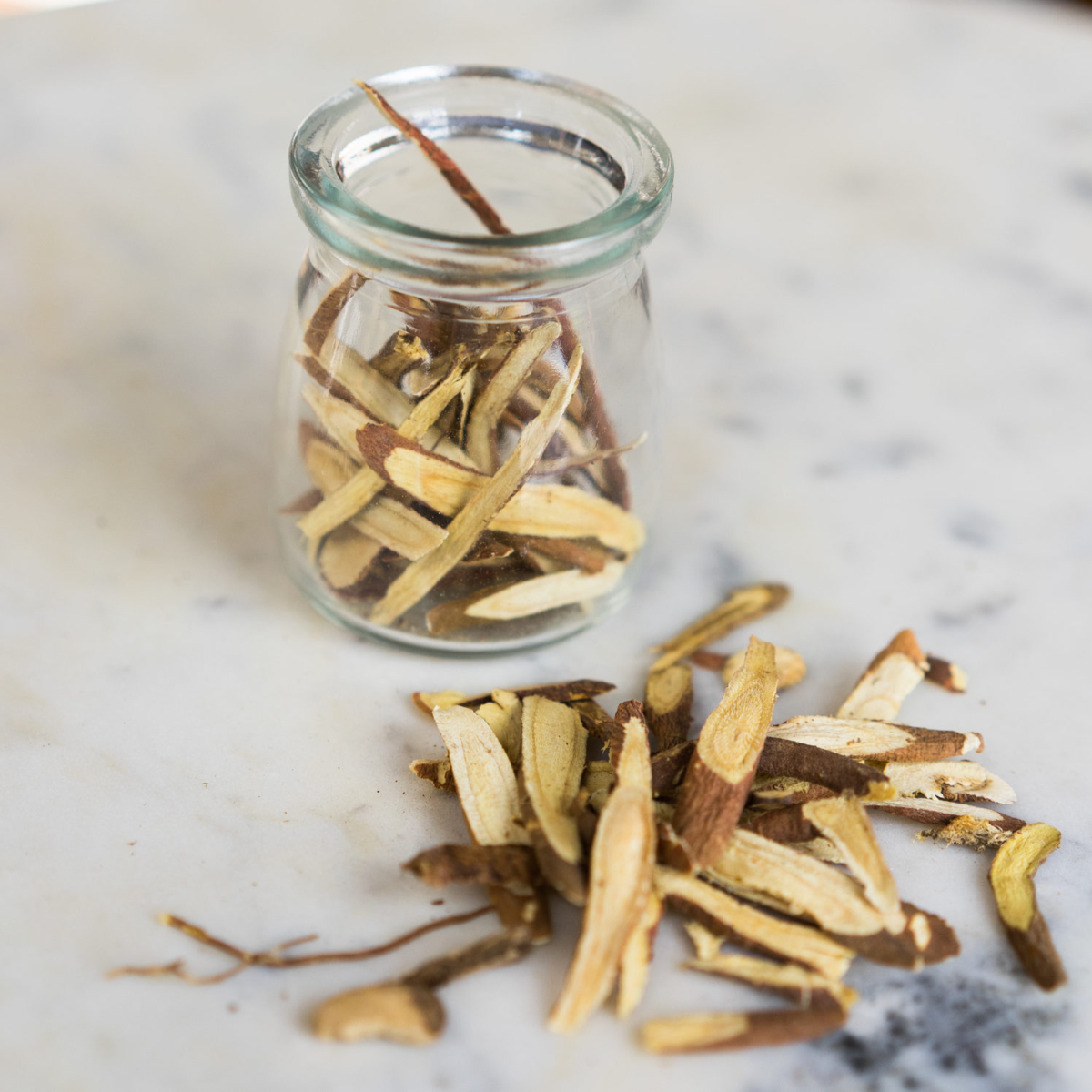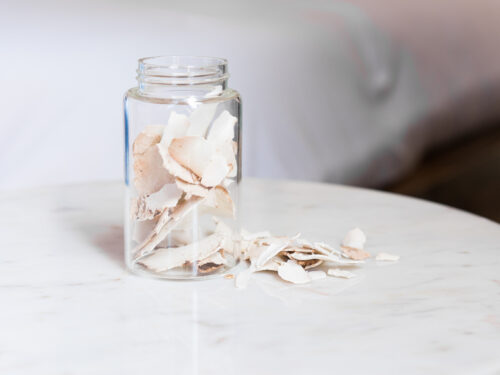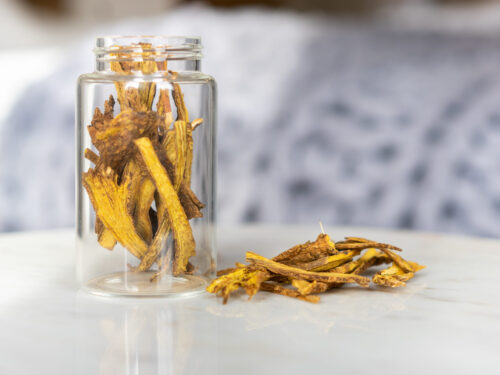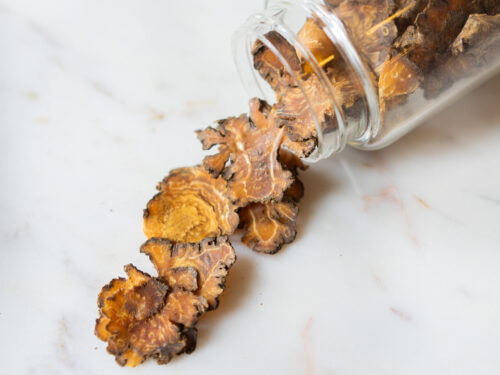
COMMON NAME (Chinese Name)
Licorice (Gān Cǎo)
BOTANICAL NAME
Glycyrrhiza Glabra; Glycyrrhiza Uralensis
USES
In Western terms, licorice is categorized as an adaptogen, antibacterial, antidepressant, antidiuretic, antihistamine, antiinflammatory, antioxidant, antitumor, antitussive. antiviral, mildly demulcent, expectorant, hepatoprotective and an immune amphoteric. It contains coumarin, alkaloids, polysaccharides, sitosterol, and amino acids, coumarin, alkaloids, polysaccharides, sitosterol, and isoflavones like genistein.
Licorice root is used in small amounts in the majority of Traditional Chinese Medicine herbal formulas as it harmonizes the herbs and makes them work better, without reaching a dose that might cause hypertension. The herb is categorized as an herb that tonifies qi. It is neutral when raw and slightly warm when dry-fried. This allows it to be used for a wide variety of people. The herb is categorized as sweet and affects all 12 channels, especially the Lung, Heart, Spleen, and Stomach channels.
Licorice, is called an immune amphoteric which means it will balance your immune system at normal doses. It’s widely used in Eastern and Western treatment protocols for autoimmune disease. It’s important to note that this isn’t a home-treatment as licorice in high quantities can potentiate Prednisone. It can also be used to treat ileitis, leaky gut syndrome, IBS, Crohn’s disease, and IBD as it is antispasmodic to the bowel. It also has benefits by virtue of being demulcent and antiinflammatory to the gastric mucosa and inhibiting Helicobactor pylorii, so it is useful for gastric and duodenal ulcers. Licorice can also be useful in treating Herpes and Shingles. For this it is used topically as a wash, compress or poultice.
Oral licorice supplementation is most often a part of cough suppressant and asthma-control remedies, as its most significant impact is to reduce lung and airway inflammation, relax tracheal constriction, increase lubrication, and boost natural steroid hormone functions. There is also some evidence to suggest that licorice extract is an expectorant, helping to expel mucus from the lungs and airways, making it useful in the treatment of different viral and bacterial upper respiratory infections, like sore throat and bronchitis.
PREPARATION & ADMINISTRATION
Licorice supplements are most commonly prepared by drying, then decocting the root. Most dosing instructions give the expected amount of root to use for infusion or decoction, for example, 8-15g for day-to-day preventive use and 100g for disease treatment. This extracts the essential oils from the root, enabling users to drink licorice as an oral supplement or mix it with food to add both flavor and medicinal properties. These amounts would not be expected to yield more than the maximum recommended dose of 1800mg of ingestible licorice extract. It’s worth noting that most commercial “licorice” and licorice-flavored products don’t contain any natural licorice, instead getting their flavor from star anise.
PRECAUTIONS
Licorice can be harmful to infants who are nursing, so women who are breastfeeding should avoid it. When taken in large or heavily concentrated doses, licorice can potentiate Prednisone and may cause visual symptoms not too much different than those of an ocular migraine (floaters, flashing lights, halos around lights). These side-effects tend to impact migraine sufferers more/faster than non-migraine sufferers.
You should consult with a certified herbalist, physician or other qualified healthcare professional before taking licorice.
REFERENCES
Chen, John, Chen, T & Cramton, L. Art of Medicine Press, Inc. City of Industry, CA USA. 2003. 1327 pp ISBN: 0-9740635-0-9 , http://aompress.com/herbology
Examine.com. “Licorice Supplement – Science-Based Review on Benefits, Dosage, Side Effects.” Examine.com, 3 Oct. 2019
Fraunfelder, Frederick T. “Herbal Medicine and Dietary Supplement Induced Ocular Side Effects.” Clinical Ocular Toxicology, W.B. Saunders, 10 Feb. 2013
Guo, A., He, D., Xu, H. B., Geng, C. A., & Zhao, J. (2015). Promotion of regulatory T cell induction by immunomodulatory herbal medicine licorice and its two constituents. Scientific reports, 5, 14046. https://doi.org/10.1038/srep14046
Mark, John D. “Asthma.” Integrative Medicine (Fourth Edition), Elsevier, 28 Apr. 2017
Mills, S. & Bone, K., Principles and Practice of Phytotherapy, Churchill Livingstone, 2000.
Sabouri Ghannad, M., Mohammadi, A., Safiallahy, S., Faradmal, J., Azizi, M., & Ahmadvand, Z. (2014). The Effect of Aqueous Extract of Glycyrrhiza glabra on Herpes Simplex Virus 1. Jundishapur journal of microbiology, 7(7), e11616. https://doi.org/10.5812/jjm.11616
Xu Xiang Cai, The English-Chinese Encyclopedia of Practical Traditional Chinese Medicine, The Chinese Materia Medica, Beijing, 1989.
Yu, J. Y., Ha, J. Y., Kim, K. M., Jung, Y. S., Jung, J. C., & Oh, S. (2015). Anti-Inflammatory activities of licorice extract and its active compounds, glycyrrhizic acid, liquiritin and liquiritigenin, in BV2 cells and mice liver. Molecules (Basel, Switzerland), 20(7), 13041–13054. https://doi.org/10.3390/molecules200713041
Yang, Rui, et al. “The Anti-Inflammatory Activity of Licorice, a Widely Used Chinese Herb.” Pharmaceutical Biology, U.S. National Library of Medicine, Dec. 2017
Winston, David & Kuhn, M. Herbal Therapy and Supplements: A Scientific and Traditional Approach. 30 Oct. 2007 https://books.google.com/books?id=gd4PAAAAQBAJ&pg=PA170&lpg=PA170&dq=Winston,+David+%26+Kuhn,+M.+Herbal+Therapy+and+Supplements:+A+Scientific+and+Traditional+Approach.+30+Oct.+2007&source=bl&ots=u_aSetSL2R&sig=ACfU3U2j8VBRFPiVwbWWgsz7jK_k59UBaQ&hl=en&ppis=_c&sa=X&ved=2ahUKEwiE4ebqqe3nAhXMLc0KHQ4wCkcQ6AEwA3oECAsQAQ#v=onepage&q=Winston%2C%20David%20%26%20Kuhn%2C%20M.%20Herbal%20Therapy%20and%20Supplements%3A%20A%20Scientific%20and%20Traditional%20Approach.%2030%20Oct.%202007&f=false



